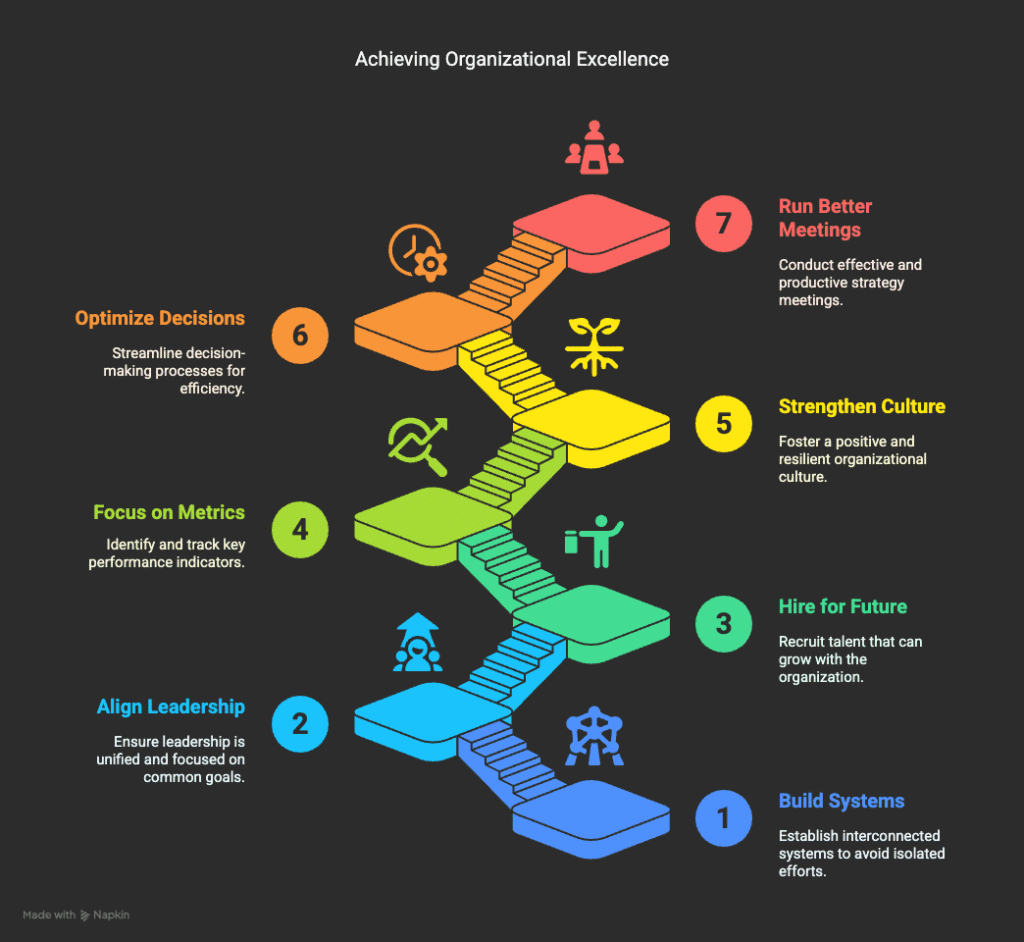How to scale up is one of the most important challenges a CEO will face—but also one of the easiest to get wrong.
Growth alone isn’t the problem. It’s what happens when growth outpaces clarity, culture, and capability. That’s when cracks appear. The systems that got you here won’t get you there. Scaling requires more than effort. It demands alignment.
At Champion PSI, we’ve coached executive teams through every stage of scale—from early chaos to enterprise-level expansion. The ones who succeed do a few things very differently.
For more depth on execution and strategic growth, see our guide to leadership development principles and explore this perspective on leadership skill sets from Harvard Business Review.
Overview of the Topics
How to scale up isn’t a guessing game. It requires a deliberate approach, clear alignment, and strategic clarity from the top down.
This blog will cover:
- Build systems, not silos
- Align your leadership team first
- Hire for the next level, not the current one
- Focus on the right metrics
- Strengthen your culture before it breaks
- Optimize decision velocity
- Run better strategy meetings
Let’s dive in and explore how to scale up the right way.

1. Build Systems, Not Silos
If your success depends on key people doing heroic work, you’re not scaling. You’re surviving.
Scalable companies design repeatable systems that make outcomes predictable. That includes:
- Structured onboarding and delegation
- Workflow visibility across teams
- Clear accountability and documentation
Systems aren’t bureaucracy. They’re what make creativity sustainable and execution scalable.
If you’re serious about how to scale up, focus on making processes repeatable and transparent.
Strategic planning plays a critical role in scaling. This approach to creating a strategic plan breaks it down.
2. Align Your Leadership Team First
Nothing derails a scaling business faster than a misaligned leadership team.
Here’s what misalignment looks like:
- Different departments solving different problems
- Turf wars over priorities
- Leadership that lacks a shared vision
Before you scale processes, scale trust. That means every leader is clear on the direction, knows how decisions are made, and understands their role in execution.
Want to know how to scale up with confidence? Start by building trust across your leadership team.
This deep dive into leadership team alignment explores the mechanics behind it.
3. Hire for the Next Level, Not the Current One
One of the fastest ways to stall growth is to hire only for present needs.
Scaling requires building the team you’ll need 12–24 months from now. That means hiring:
- People with experience operating at your next level
- Leaders who think strategically, not just execute tasks
- Talent who can grow roles, not just fill them
Knowing how to scale up involves not just expanding headcount, but strategically designing your future organization.
Yes, it costs more upfront. But hiring reactively will cost you even more in lost momentum later.
4. Focus on the Right Metrics
Many CEOs chase numbers that look good but don’t actually help scale.
Vanity metrics (like social reach or top-line growth without profit) often distract from what really matters:
- Operational efficiency
- Revenue per employee
- Customer retention and LTV
- Internal alignment and engagement
To truly understand how to scale up effectively, track the metrics that drive sustainable growth.
These scaling challenges solutions offer a closer look at the obstacles leaders often face.
5. Strengthen Your Culture Before It Breaks
You won’t keep your culture by accident. You’ll have to fight for it as you grow.
During scale, culture risk rises. Communication dilutes. Values drift. Leaders become bottlenecks instead of culture carriers.
The companies that navigate this well:
- Codify their values into behaviors
- Design rituals that reinforce alignment
- Actively protect team trust and psychological safety
Culture is often the overlooked answer to the question of how to scale up without losing what made your company special.
Your brand is how the market sees you. Your culture is how your people experience you. Both matter when scaling.
6. Optimize Decision Velocity
When companies grow, decision-making often slows. Too many approvals. Too much control. Not enough clarity.
Scaling requires decision velocity. That doesn’t mean recklessness. It means:
- Clear decision rights at every level
- Fewer bottlenecks at the top
- Real-time information flow
The best CEOs don’t just delegate tasks. They distribute thinking. If you’re still the hub of every decision, scale will stall. See CEO performance insights from McKinsey for data-backed strategy here. Also consider PwC’s insights on decision-making process from their 28th Annual Global CEO Survey.
If you want to learn how to scale up and stay agile, decision velocity is your edge.
7. Run Better Strategy Meetings
As your company grows, your meetings either become engines—or anchors.
Strategy sessions should be:
- Focused on decisions, not discussions
- Tied to outcomes, not just updates
- Structured with pre-reads and post-meeting accountability
Strong meetings are one of the most underappreciated tools in scaling. Weak ones drain alignment and energy.
Want to know how to scale up while keeping clarity? Build better meetings.
A breakdown of strategy meeting components can sharpen your approach.
Real-World Example: Impact Power Solutions’ Strategic Scaling
Impact Power Solutions (IPS), a solar energy company based in Minnesota, offers a clear case study in how to scale up effectively without sacrificing alignment or cash flow. Over five years, IPS expanded its revenue from $3 million to $38 million by focusing on structure, clarity, and execution.
Here’s how they did it:
- Restructured their leadership team by aligning roles with individual strengths, appointing a new CEO and a Chief Innovation Officer to guide scale.
- Instituted daily huddles at exactly 2:32 p.m., creating ritualized alignment and fast issue resolution across teams.
- Built a one-page strategic plan (OPSP) to distill and share company priorities, reviewed and updated regularly with full team visibility.
- Established weekly cash flow reviews, which provided early visibility into financial gaps and helped fund growth sustainably.
These simple but consistent practices allowed IPS to scale fast—without losing control.
You can read the full case in the Growth Institute’s scaling company examples.
FAQ: How to Scale Up
What’s the difference between growth and scale?
Growth adds more—more people, more resources. Scale means growing revenue without growing costs at the same pace. It’s about working smarter, not just harder.
When should I start thinking about how to scale up?
Start before you think you’re ready. By the time scaling feels urgent, it’s often too late to build the foundation without pain.
What’s the biggest mistake CEOs make when trying to scale?
Assuming what worked at one stage will work at the next. Scaling requires unlearning and rebuilding.
How does coaching support scaling a business?
Coaching helps leaders create clarity, make decisions faster, and adapt their thinking to each new level of complexity. Learn more about executive coaching for leaders and explore executive coaching essentials in this article from Harvard Business Review.
Can our company scale without losing its culture?
Yes—but only if you treat culture like a strategic priority. Codify it. Reinforce it. Hold leaders accountable to it as you grow.
How to Scale Up: 7 Strategies CEOs Can’t Ignore — Conclusion
If you’re a CEO or senior leader asking how to scale up, remember this: scale doesn’t come from size. It comes from clarity, alignment, and execution.
The 7 strategies above aren’t theory. They’re battle-tested. They separate companies that grow for a quarter from companies that grow for a decade.
Ready to get started? Book a free 30-minute call with an expert coach to explore how to scale up your business with clarity and confidence.










